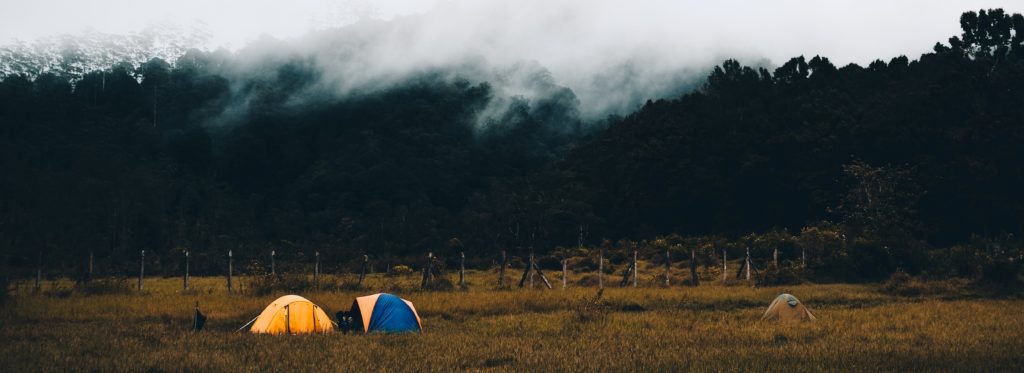How to Waterproof a Tent DIY

Waterproofing your tent is crucial if you plan to enjoy camping, no matter what season it is. Unexpected rain can arrive on what may seem the most beautiful days in the summer, spring, or fall. And in winter, you’ll need to keep ice and snow from saturating your shelter. Even if your tent comes with a rainfly, you’ll benefit from DIY water shielding products, including a superhydrophobic spray, a tarp, and seam tape.
Here’s what each DIY solution offers toward waterproofing:
What Spray Can Help Keep Rain And Snow Out?
The best spray for keeping rain and snow off your tent is one with superhydrophobic technology, such as NeverWet. There’s a reason why trusted brands of rain-repelling products like Totes and ScentLok use NeverWet’s superhydrophobic technology. We’ve been added water-resistance to commercial products for decades.
Superhydrophobic products force surfaces to repel liquids by forming a contact angle. The liquid forms into droplets on surfaces protected with NeverWet, and the angle forces those droplets to roll off and carry grime away with them.
Our retail products make it easy for you to have that same water-repelling technology on your camping gear. NeverWet Extreme Fabric Water & Mud Repellent is an easy, one-step superhydrophobic treatment ideal for adding a shield of protection to your tent. This is especially helpful for inexpensive tents which likely won’t come with any type of water repellency.
Yet even higher-end camping tents can be fortified using NeverWet. Read the manufacturer’s directions and test a small area of the tent fabric prior to applying it to the entire tent. NeverWet can be applied to a rainfly section of the tent for added rain repellency.
Consider using NeverWet Extreme Fabric Water & Mud Repellent on your rain jackets and backpack, too. With age, products can lose their water repellency and NeverWet spray can restore that along with added protection from grime buildup.
How To Waterproof Your Tent Using A Tarp?
An inexpensive tarp is a smart investment when it comes to camping gear. You can pitch your tent on top of a tarp as an extra ground shield or you can use the tarp as an added layer of protection, placing it over your tent.
Tarp kits that include poles and guy lines are your best bet for easy DIY tent waterproofing because you’ll have all the tools necessary for quick assembly. Choose a tarp that has grommet holes that will make it easy for rope or the guy lines to pull through.
Lay the tarp on top of your tent and stake down the four corners using your guy lines. Push those lines through the grommets on your tarp and pull each corner taught so that there are no gaping areas on the tarp “roof.” Watch this video for a visual explanation of how to use a tarp to help waterproof your tent.
Want to make your tarp work even harder? Apply NeverWet Extreme Fabric Water & Mud Repellent to the tarp surface before heading to the campsite. Follow manufacturer’s directions regarding drying times and surface coverage capacity.
Can Seam Tape Help Keep Water Out Of My Tent?
Seam sealers can help keep moisture from entering your tent. Because tent seams tend to be weakened areas, sealers strengthen these areas and prevent rain from seeping through.
Seam tape isn’t a permanent fix, however. With time, it can disintegrate. Monitor the condition of your tent, especially where this has been applied, and replace where needed. Keep in mind that heat will hasten seam tape disintegration and can cause it to quickly become brittle. Tents should be stored in climate-controlled areas whenever possible.
How Long Does Tent Waterproofing Last?
On average, NeverWet hydrophobic technology will add water repellency to your outdoor tent for about 6 months. Reapplication is recommended at the first signs of degradation.
A tarp can last for years, depending on how harsh the weather conditions are. High winds and abrasive surfaces will shorten its lifespan. A tarp treated with NeverWet superhydrophobic technology will have added months to its ability to repel water. Lastly, the lifespan of seam tape will vary per brand and it can deteriorate if left in high-heat storage.